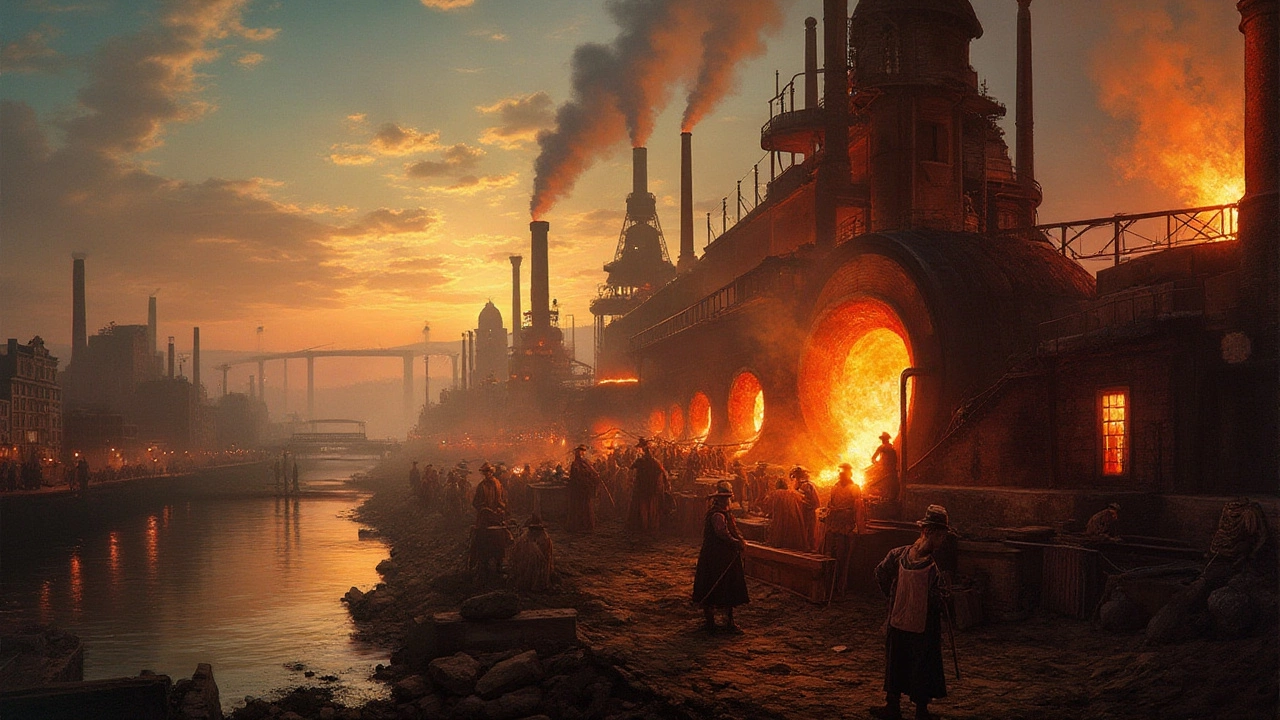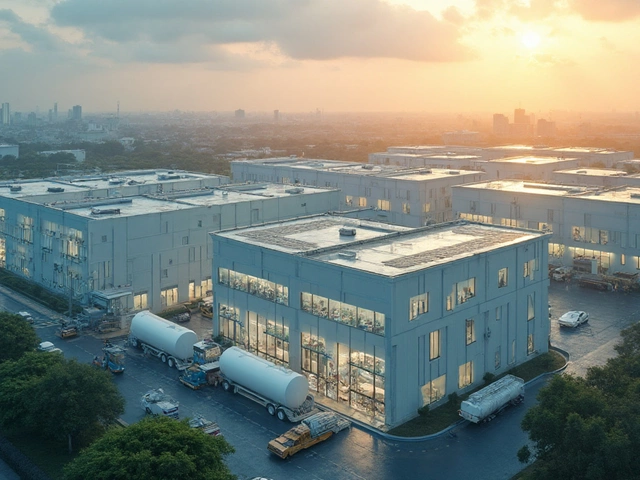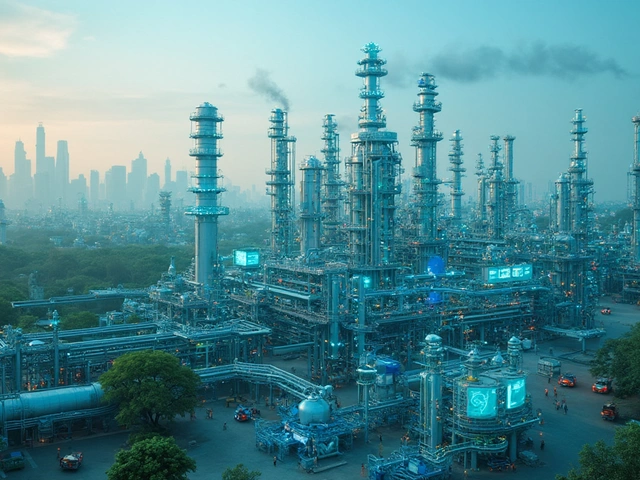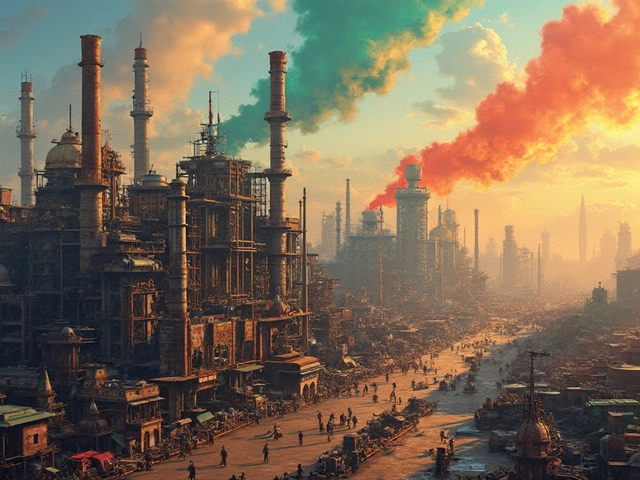Pittsburgh's reputation as the 'Steel City' is not just a catchy moniker, but a reflection of its pivotal role in shaping America’s industrial landscape. Nestled at the confluence of three rivers, Pittsburgh's geographical location was instrumental in its development into a steel superpower. The city found itself blessed with rich deposits of coal and iron, essential ingredients for steel production, making it an ideal location for steel manufacturing.
From the late 19th century onwards, Pittsburgh was the epicenter of steel production, driving the country's industrial boom and earning itself an esteemed identity synonymous with steel. But, what led to such meteoric rise? Delve into the fascinating blend of natural resources, entrepreneurial spirit, and pioneering technology that made Pittsburgh a household name in the annals of industrial history. How did it transition from soot-laden skies and bustling steel mills to the vibrant, diversified city it is today?
Journey with us as we explore the intricate tapestry of Pittsburgh's steel saga, uncovering stories of iconic steel moguls, discovering the city's profound transformation after the decline of steel, and understanding how the echoes of steel still resonate in the streets of modern-day Pittsburgh.
- The Birth of the Steel Industry in Pittsburgh
- Strategic Factors Behind Pittsburgh's Steel Empire
- Key Figures and Companies in Pittsburgh's Steel History
- Pittsburgh's Evolution Post-Steel Industry
- Legacy and Recognition Today
The Birth of the Steel Industry in Pittsburgh
Pittsburgh's journey to becoming America's Steel City began in the mid-19th century, where its geographical advantages played a crucial role. Situated at the navigational nexus of the Allegheny, Monongahela, and Ohio rivers, Pittsburgh provided an ideal location for transporting raw materials and finished goods.
The city was rich in essential resources like coal and iron ore, which were abundant in the surrounding areas. This naturally made Pittsburgh a prime location for the burgeoning steel industry during that era. The development of the city was further fueled by the construction of the Pennsylvania Main Line Canal and the extension of the Pennsylvania Railroad, which connected Pittsburgh with the rest of the United States, allowing for efficient movement of resources and products.
The Role of Early Innovators
A significant figure in Pittsburgh's early steel history was Andrew Carnegie, a man who would become synonymous with the industry itself. Starting in the iron business, Carnegie introduced the Bessemer process to the United States, which significantly sped up steel production and lowered costs. This innovative technology replaced the slow and costly traditional methods, putting Pittsburgh at the forefront of cheap and mass-produced steel.
In 1875, Carnegie built the J. Edgar Thomson Steel Works in Braddock, just outside of Pittsburgh, marking a pivotal moment in the city's industrial history. This plant became one of the largest steel-producing facilities in the world and helped cement Pittsburgh’s status as the heart of America's industrial revolution.
Pittsburgh's First Steel Boom
The late 1800s saw an explosion in industrial activity in Pittsburgh, as steel mills and foundries sprouted throughout the city. With the demand for steel escalating due to the construction of railroads, bridges, and skyscrapers, Pittsburgh's steel industry was a key contributor to the city's economic prosperity and population growth.
| Year | Steel Production (in thousands of tons) |
|---|---|
| 1875 | 1,200 |
| 1890 | 4,500 |
| 1900 | 11,500 |
This period is often described as Pittsburgh's first steel boom, where innovation and the strategic utilization of natural resources played an indispensable role in shaping the city's economic landscape. By the early 20th century, Pittsburgh had emerged as the undeniable leader of the U.S. steel industry, supplying over one-third of the nation's steel.
Industrious entrepreneurs like Carnegie weren't the only contributors; the city was home to a burgeoning labor force, composed of immigrants who arrived in search of work and opportunities. Their efforts laid the foundation for Pittsburgh’s legacy as the steel manufacturing powerhouse of the USA, a legacy that continues to be celebrated and remembered to this day.
Strategic Factors Behind Pittsburgh's Steel Empire
Pittsburgh's transformation into the Steel City was not a stroke of luck, but a remarkable convergence of geographical advantages, resource availability, and forward-thinking entrepreneurial spirit. The innate strategic features of the region laid the foundation for its steel dominance.
Geographical Location and Natural Resources
Pittsburgh sits at the confluence of the Allegheny, Monongahela, and Ohio rivers, providing unparalleled access to waterways essential for shipping raw materials and finished products. This facilitated the movement of bulky commodities like iron ore and coal, required in vast quantities for steel production.
Close proximity to rich coal fields and deposits of iron ore provided the necessary raw materials needed to fuel the steel mills. Being at the heart of coal country, Pittsburgh benefitted from an abundant supply of coke, a vital component in steel-making, used for smelting iron ore.
Innovative Industrial Leadership
Visionaries like Andrew Carnegie and Henry Clay Frick played influential roles in establishing Pittsburgh as the epicenter of the steel industry. Carnegie, with his relentless drive for efficiency and innovation, introduced the Bessemer process, an ingenious method that dramatically reduced the cost and increased the production speed of steel.
Meanwhile, Frick's contributions in the coking process and his managerial acumen ensured that the supply chain was robust and resilient. Together, they laid the groundwork for what became an industrial powerhouse.
Technological Advancements and Production Techniques
The integration of cutting-edge technology was paramount. Pittsburgh was a pioneer in adopting large-scale production techniques that pushed the boundaries of what was achievable. This technological leap, combined with a skilled labor force, enabled the production of high-quality steel at competitive prices.
Steel mills incorporated new processes like open hearth furnaces, which improved control over the composition and quality of produced steel. Such advancements kept Pittsburgh at the forefront of global steel production.
Logistics and Infrastructure
An intricate network of railways complemented the river systems, facilitating seamless transportation across the country. This logistical prowess allowed Pittsburgh not only to dominate the domestic market but also to have a strong presence in international trade.
| Year | Steel Production (Million Tons) |
|---|---|
| 1900 | 10 |
| 1920 | 60 |
| 1945 | 100 |
| 1965 | 125 |
The strategic blend of geographical advantages, plentiful resources, visionary leadership, and technological prowess positions Pittsburgh as an enduring icon in the legacy of the steel industry.

Key Figures and Companies in Pittsburgh's Steel History
The rise of Pittsburgh as the Steel City was not just a matter of geography or resources; it was also the result of visionary individuals and pioneering companies that drove the steel industry to national and global prominence. Among the most influential figures was Andrew Carnegie, whose name is synonymous with steel.
The Colossus of Steel: Andrew Carnegie
Andrew Carnegie, the son of Scottish immigrants, is often credited as the titan who propelled Pittsburgh to the forefront of the steel industry. Through his company, Carnegie Steel Company, he introduced revolutionary production techniques such as the Bessemer process, significantly cutting costs and increasing production capacity. By the turn of the 20th century, Carnegie Steel had become the largest and most profitable industrial enterprise in the world. Carnegie's relentless pursuit of efficiency and innovation laid the foundation for modern steelmaking practices.
U.S. Steel: The Giant Corporation
In 1901, Carnegie Steel was absorbed into United States Steel Corporation, commonly known as U.S. Steel, forming the world’s first billion-dollar corporation during a time when such figures were unheard of. Headquartered in Pittsburgh, U.S. Steel continued to dominate the industry through expansion and innovation, contributing significantly to the city's industrial and economic landscape.
Impact on the World Stage
U.S. Steel's influence reached international markets, setting standards across the globe. The corporation not only provided steel for domestic infrastructure but also supplied international projects, fostering economic relations worldwide. The presence of U.S. Steel in Pittsburgh attracted a wealth of talent and expertise, further cementing the city’s status as the premier steel manufacturing hub.
Other Pioneering Companies
- Jones and Laughlin Steel Company (J&L): Another cornerstone of Pittsburgh’s steel industry, J&L emerged in the mid-19th century as a leading manufacturer. Known for its shipbuilding steel, it was crucial in equipping the U.S. Navy.
- Bethlehem Steel: Although headquartered outside Pittsburgh, Bethlehem Steel’s operations around the city contributed significantly to regional output. Their advancements in the steel process helped support wartime production during the 20th century.
Shaping the Future: Legacy and Lessons
These key figures and companies did not just build a thriving industry—they also shaped the societal landscape of Pittsburgh. The city teemed with diverse communities, drawn by employment opportunities and the promise of a better life. As Pittsburgh transitioned away from its industrial roots, the legacy of these titans of steel continues to influence its development as a modern, innovative city.
| Company | Year Established | Key Contribution |
|---|---|---|
| Carnegie Steel Company | 1892 | Adoption of Bessemer process |
| U.S. Steel | 1901 | First billion-dollar corporation |
| Jones and Laughlin Steel Company | 1852 | Provided steel for shipbuilding |
Pittsburgh's Evolution Post-Steel Industry
The echoes of heavy industry had barely subsided when Pittsburgh began charting a new course, transitioning from its proud identity as the Steel City into a vibrant hub of innovation and culture. As the economic tides shifted in the 1970s and 1980s, Pittsburgh faced the daunting challenge of reshaping a city long defined by its now-fading steel mills.
From Smoke to Silicon
The decline of steel production was profound, yet Pittsburgh's resilience sparked a metamorphosis driven by technology and education. Institutions like Carnegie Mellon University and the University of Pittsburgh became the linchpins of this transformation, fostering a burgeoning tech scene and beckoning new opportunities. By the early 2000s, Pittsburgh was steadily gaining a reputation as a center for technology and innovation, with advancements in robotics, software engineering, and artificial intelligence.
The Rise of Health and Education
Pittsburgh’s healthcare sector began to blossom as well, with UPMC becoming a renowned network of hospitals providing cutting-edge medical care and research. The infusion of innovation led to significant breakthroughs, turning Pittsburgh into a nexus for healthcare advancements.
Meanwhile, the city's educational institutions became incubators for talent, contributing to the area's economic resurgence. The synergy between health, education, and technology set the stage for a diversified economy, reducing reliance on steel and establishing a solid foundation for future growth.
Economic and Cultural Renaissance
Embracing its industrial past while forging a new identity, Pittsburgh underwent an urban renaissance. Abandoned steel mills and factories found new life as mixed-use developments, cultural districts, and iconic venues. Boasting a lively arts scene and esteemed museums, Pittsburgh celebrated its cultural diversity and heritage.
Increased livability was another milestone, with the city topping numerous lists for best places to live. Investments in green spaces, riverfronts, and sustainable practices earned Pittsburgh accolades for its commitment to environmental stewardship.
Statistics Highlighting the Transformation
| Sector | Growth Rate (2000-2020) |
|---|---|
| Technology | 80% |
| Healthcare | 65% |
| Education | 50% |
As evidenced by these growth rates, the diversification of Pittsburgh's economy has been a pivotal factor in its renaissance. The once soot-covered city evolved into a place where history coexists with progress, becoming a beacon of hope for former industrial powerhouses seeking reinvention.
Pittsburgh today stands as a testament to the relentless human spirit, adapting and thriving in the face of adversity. It serves as an inspiring model for cities around the world—illustrating how a legacy of steel can evolve into an inclusive, sustainable, and innovative future.

Legacy and Recognition Today
Though the blast furnaces and rolling mills of yesteryear have faded from Pittsburgh's landscape, the city's legacy as the Steel City is indelibly etched in its cultural and economic fabric. Today, Pittsburgh stands as a testament to a successful reinvention, seamlessly weaving its storied industrial past into a vibrant future.
The Cultural Heritage
Pittsburgh's rich steel history is celebrated through a plethora of museums, memorials, and cultural institutions. The Carnegie Science Center, for example, houses exhibits that pay homage to the city’s industrial roots, while the Rivers of Steel National Heritage Area offers guided tours at historic steel sites, preserving the stories of the men and women who built the industry. Each year, the Pittsburgh Arts and Lectures series even delves into the transformative tales from the city's steel era, keeping its legacy alive through the arts.
Economic Transformation
While the smokestacks no longer dominate the skyline, Pittsburgh has smartly leveraged its industrial foundation to nurture innovation across diverse sectors. The city is now a thriving hub for technology and education, housing a dynamic ecosystem of startups and research institutions such as Carnegie Mellon University. The tech sector has seen rapid growth, with giants like Google and Uber establishing major operational outposts there.
Environmental Recognition
Proud of its past yet focused on green innovation, Pittsburgh has made significant strides in sustainable urban development. The city's transformation from an industrial heartland to a leader in eco-friendly initiatives is capturing attention globally. With the implementation of projects like the Pittsburgh 2030 District, which aims to drastically reduce energy use and water consumption, the city is setting benchmarks in sustainability.
Urban Renewal Projects
Driven by an unwavering commitment to revitalization, Pittsburgh has witnessed a resurgence in urban development, blending historical landmarks with modern architecture. This metamorphosis is embodied in the success of initiatives like the Strip District, an area rejuvenated from a former industrial zone to a bustling market district, vibrant with dining, shopping, and entertainment.
The echoes of its incredible past still resonate, and Pittsburgh's nickname as the vibrant Steel City endures, signifying resilience, innovation, and an unyielding embrace of change. Visitors and residents alike find inspiration in a city that once fueled an entire nation and continues to forge new paths in the 21st century.







